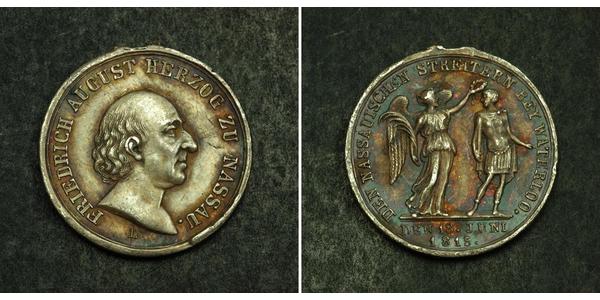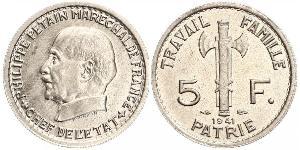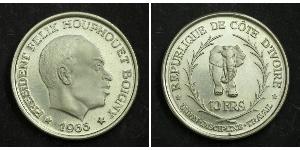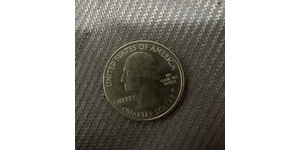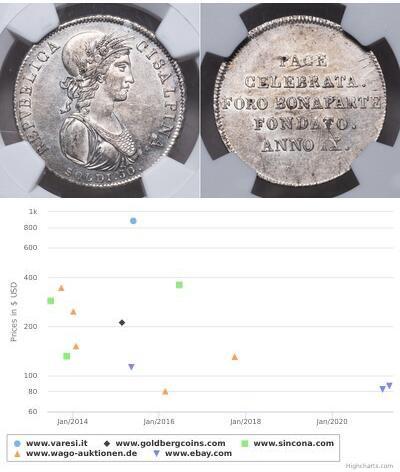(продана за $103.0)
1818, Nassau (Duchy), Friedrich August. Silver "Waterloo Veterans" Medal. Rare!
Mint Year: 1818
Assayer: Julius 3387.
Condition: Broken suspension loop, otherwise VF+
Denomination: Small Medal - given to fighters who survived the battle of Waterloo against Napoleon I.
Diameter: 18mm
Material: Silver
Weight: 3.16gm
Obverse: Bare bust of Prince Friedrich August of Usingen right. Mint official's initial (L) below.
Legend: FRIEDRICH AUGUST HERZOG ZU NASSAU.
Reverse: Winged and togate figure of Victory, holding palm and wreathing stainding soldier in roman armor.
Legend: DEN NASAUISCHEN STREITERN BEY WATERLOO. ("To the Nassau Fighters at Waterloo!")
Exergeu: DEN 18. JUNI 1818. ("18th June 1818")
The Battle of Waterloo was fought on Sunday, 18 June 1815, near Waterloo in present-day Belgium, then part of the United Kingdom of the Netherlands. A French army under the command of Napoleon Bonaparte was defeated by two of the armies of the Seventh Coalition: an Anglo-led Allied army under the command of the Duke of Wellington, and a Prussian army under the command of Gebhard Leberecht von Blücher, Prince of Wahlstatt.
Upon Napoleon's return to power in March 1815, many states that had opposed him formed the Seventh Coalition and began to mobilize armies. Wellington and Blücher's armies were cantoned close to the north-eastern border of France. Napoleon chose to attack them in the hope of destroying them before they could join in a coordinated invasion of France with other members of the coalition. Waterloo was the decisive engagement of the Waterloo Campaign and Napoleon's last. According to Wellington, the battle was "the nearest-run thing you ever saw in your life". The defeat at Waterloo ended Napoleon's rule as Emperor of the French, and marked the end of his Hundred Days return from exile. Napoleon abdicated 4 days later, and on 7 July coalition forces entered Paris.
After the Battle of Quatre Bras, Wellington withdrew from Quatre Bras to Waterloo. After the simultaneous Battle of Ligny the Prussians withdrew parallel to Wellington, drawing a third part of Napoleon's forces away from Waterloo to the separate and simultaneous Battle of Wavre. Upon learning that the Prussian army was able to support him, Wellington decided to offer battle on the Mont-Saint-Jean escarpment, across the Brussels road. Here he withstood repeated attacks by the French throughout the afternoon, aided by the progressively arriving Prussians. In the evening Napoleon committed his last reserves to a desperate final attack, which was narrowly beaten back. With the Prussians breaking through on the French right flank Wellington's Anglo-allied army counter-attacked in the centre, and the French army was routed.
The battlefield is located in the municipalities of Braine-l'Alleud and Lasne, about 15 kilometres (9.3 mi) south of Brussels, and about 2 kilometres (1.2 mi) from the town of Waterloo. The site of the battlefield today is dominated by a large monument, the Lion's Mound. As this mound was constructed from earth taken from the battlefield itself, the contemporary topography of the battlefield near the mound has not been preserved.
Friedrich August, Duke of Nassau, Prince of Nassau-Usingen (23 April 1738 – 24 March 1816, Wiesbaden) was the last Prince of Nassau-Usingen and, jointly with his cousin, Friedrich Wilhelm of Nassau-Weilburg, first Duke of Nassau. He died without surviving male issue and was succeeded by his cousin's son, Wilhelm.
Friedrich August, born in Usingen, was a younger son of Prince Charles of Nassau-Usingen and Princess Christiane Wilhelmine of Saxe-Eisenach (daughter of John William III, Duke of Saxe-Eisenach). From 1744, he lived with his parents in Schloss Biebrich in Wiesbaden. He followed a military career in the army of the Holy Roman Empire and served in the Seven Years' War. In 1790, he became a Field Marshal.
On 17 May 1803, he succeed as the Prince of Nassau-Usingen when his elder brother, Charles William died without male heirs. On 6 July 1806, he joined the Confederation of the Rhine in order to prevent Napoleon from annexing the principality. Shortly thereafter, on 30 August 1806, he agreed with his cousin Friedrich Wilhelm of Nassau-Weilburg that their territories should be united into a single Duchy of Nassau with Frederick Augustus as the first duke and Frederick William as co-ruler. Since Friedrich August' sons had died young, it was also agreed that the combined duchy and sole rulership would pass to the heir of the Nassau-Weilburg line.
After Napoleon's defeat at the Battle of Leipzig, Friedrich August joined in the allies fighting against the French Emperor. Nassau's troops fought under the command of Arthur Wellesley, 1st Duke of Wellington at the Battle of Waterloo. At the Congress of Vienna, the unification of the Duchy of Nassau was approved and the duchy joined the German Confederation.
Friedrich August was an enlightened and liberal ruler who established reforms such as the elimination of tax privileges for the nobility, the introduction of press freedom and the constitution for a modern state. His court at the Biebrich Castle was praised by visitors for its serenity and hospitality.

|
Добавив:
anonymous 2016-05-10 |
536 монет було додано з 2025-06-11 по 2025-06-18
Одна з них:

